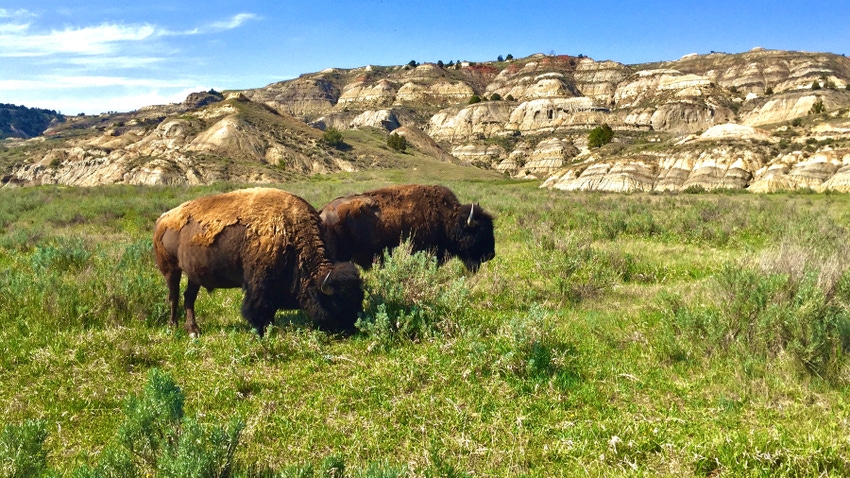
Theodore Roosevelt, the 26th president of the United States, is well known for his conservation work while in the White House. But Roosevelt’s interest in conservation began in the Dakotas even before his presidency.
According to official White House history, Roosevelt was born in 1858 in New York City, far from the Badlands of the Dakotas. After the tragic death of his mother and wife on Valentine’s Day in 1884, Roosevelt spent a majority of his time on his ranch in the Badlands in what was then known as Dakota Territory. His home operation was named the Elkhorn Ranch, and the “Cowboy President” spent his days living in the saddle.
Roosevelt famously said, “I never would’ve been president if it had not been for my experiences in North Dakota.” He first became an investor in the Maltese Cross Ranch and then the Elkhorn Ranch, where he ran cattle until the cold winter of 1886-87 caused the loss of over half his herd. North Dakota Tourism says that he sold his last cattle in 1898 and returned to politics full time.
His history and time spent in the Dakotas stretched from 1883 to his final visit in fall 1918, preceding his death at age 60. Roosevelt famously told a crowd in Medora, N.D., during a whistlestop campaign in 1900 that the Badlands were where “the romance of my life began.”
He was elected governor of New York in 1898, and was elected as vice president in 1900. After President William McKinley was assassinated in Buffalo, N.Y., Roosevelt was sworn in as president on Sept. 14, 1901.
Roosevelt wrote a memoir of his time in the Badlands, titled “Hunting Trips of a Ranchman: Sketches of sport on the Northern Cattle Plains.” In the first chapter, Roosevelt references the ranching landscape of the Badlands writing, “The cattle rove free over the hills and prairies, picking up their own living in the winter, all the animals of each herd having distinctive brands on them. The cowboys form a class by themselves, and are now typically representative of the wilder side of Western life.”
The rest of the book details experiences of hunting waterfowl, white-tailed deer, mountain sheep, buffalo, elk and bear. It is plain for readers to see Roosevelt’s love of the Western way of life and the Badlands throughout his memoir.
Making his mark
Many residents in the Dakotas can see glimpses today of Roosevelt’s legacy:
School mascots are named “Rough Riders,” after Roosevelt’s calvary, which charged up San Juan Hill in 1898 during the Spanish-American War.
The Theodore Roosevelt Presidential Library and Museum is located in Medora, N.D.
Teddy bears were invented in honor of the former president.
Historic sites such as Theodore Roosevelt National Park memorialize the conservation work he accomplished.
Some of Roosevelt’s highest achievements were in conservation. Through his work, the National Forest Service was established in February 1905, and later the same year he declared Wichita Forest, Okla., as the first federal game preserve. Roosevelt also established many National Monuments including Jewel Cave near Custer, S.D.

CONSERVATIONIST PRESIDENT: Roosevelt ranched in the Dakota Territory between 1884 and 1898, and returned to the Badlands even while president. (North Dakota Tourism)
The legacy of Roosevelt lives on in the 200 million acres of public lands he helped establish during his presidency — with150 million of those acres set aside as national forests. During his presidency, he convened the first White House governors conference to discuss conservation of natural resources. While his writings depict hunting trips and kills, the lament for loss of wild lands is seen.
The National Park Service shares this quote from Roosevelt for his stance on conservation: “We have become great because of the lavish use of our resources. But the time has come to inquire seriously what will happen when our forests are gone; when the coal, the iron, the oil, and the gas are exhausted; when the soils have still further impoverished and washed into the streams, polluting the reivers, denuding the fields and obstructing navigation.”
In 1947, President Harry Truman signed the bill to create Theodore Roosevelt National Memorial Park. President Jimmy Carter signed legislation recognizing it as Theodore Roosevelt National Park, where it remains the only national park named after a person.
Through his conservation work and time spent in the rough and rugged plains of the Dakotas, Roosevelt has become a legend that lives on today in Dakotas and beyond. Read more about the life of Theodore Roosevelt from The White House and North Dakota Tourism.
About the Author(s)
You May Also Like






